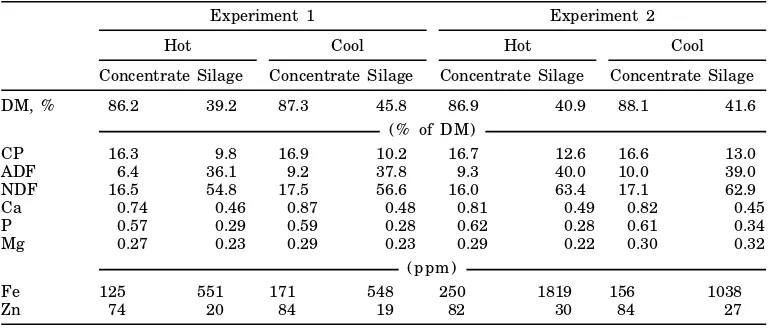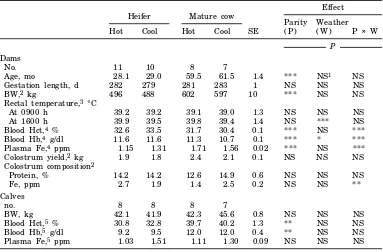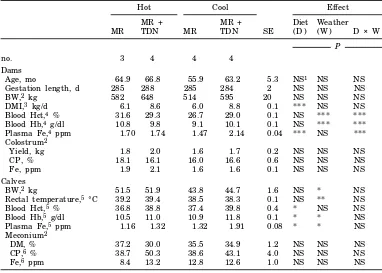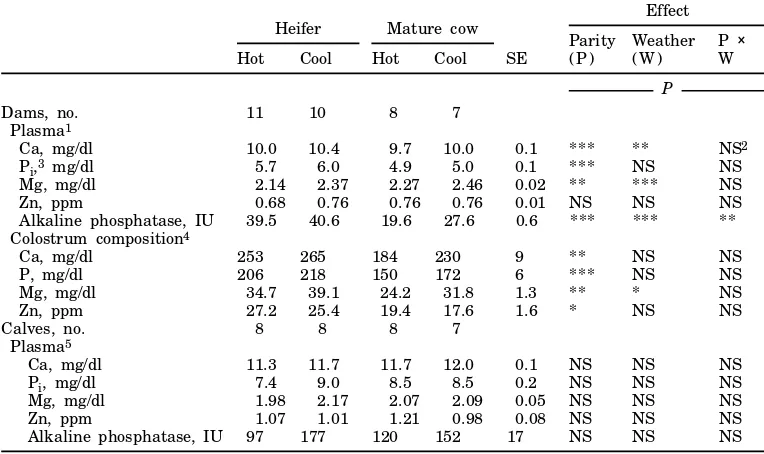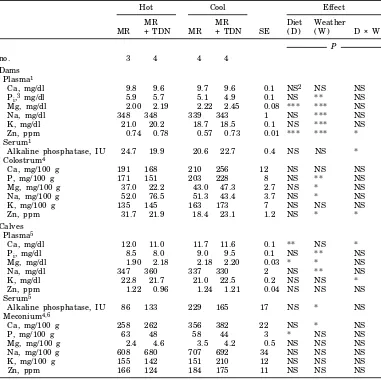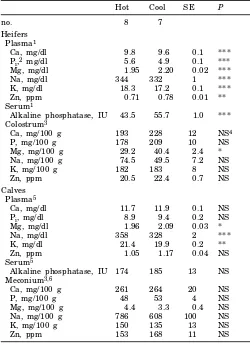NUTRITION, FEEDING, AND CALVES
1998 J Dairy Sci 81:1581–1590 1581
Received November 17, 1995. Accepted January 30, 1998.
1Present address: Hokkaido National Agricultural Experiment
Station, Sapporo 062, Japan.
2Corresponding author.
3Present address: Bogor Agricultural University, Indonesia.
4Present address: Fukui Prefectural Animal Experiment
Sta-tion, Mikuni 913, Japan.
Effect of Restricted Feed Intake of Dams and Heat Stress
on Mineral Status of Newborn Calves
S. KUME,1,2 T. TOHARMAT,3 and N. KOBAYASHI4
Department of Animal Nutrition, National Institute of Animal Industry, Tsukua 305, Japan
ABSTRACT
To clarify the effects of restricted feed intake, heat stress, and parity on the mineral status of cows and heifers around parturition and on the mineral status of their calves during 1 wk of age, data were collected from 66 Holstein cows and heifers and their calves. In Experiment 1, 36 heifers and mature cows that calved during hot or cool weather were fed to meet require-ments for total digestible nutrients (TDN), protein, and minerals. In Experiment 2, 15 mature cows that calved during hot or cool weather were fed to meet maintenance requirements for TDN plus require-ments for TDN for the last 2 mo of gestation, and 15 heifers were fed to meet TDN requirements. Heat stress increased rectal temperatures of newborn calves. Blood hematocrit and hemoglobin of heifers around parturition were higher than those of mature cows, but blood hematocrit and hemoglobin of calves born from heifers were lower. The restricted feed intake of dams decreased blood hematocrit and hemoglobin as well as plasma Fe of calves in hot and cool weather. Plasma Ca, inorganic P, and alkaline phosphatase as well as colostral Ca, P, Mg, and Zn of heifers were higher than those of mature cows, but plasma Mg of heifers was lower. Plasma Mg of calves and their dams was lower in hot weather than in cool weather, and restricted feed intake accelerated the reduction in plasma Mg of calves and their dams during hot weather. Plasma Na of calves and their dams was higher in hot weather than in cool weather. Heat stress increased plasma K of heifers and their calves. Heat stress increased Ca concentration in meconium of calves born from cows, and the restricted feed intake increased P concentrations in meconium. These results suggest that the maintenance of
opti-mum erythropoiesis and mineral status in heat-stressed periparturient cows and heifers and their calves must be met by dietary energy and minerals that are fed at maintenance concentrations plus ex-cess requirements neex-cessary during the gestation period.
(Key words: feed intake, hot weather, mineral sta-tus, newborn calves)
Abbreviation key: Hb = hemoglobin, Hct = hematocrit, Pi = inorganic P.
INTRODUCTION
The mineral status of newborn calves varies ac-cording to a number of factors. Many farmers may reduce the overall costs of raising heifers by reducing calf mortality. Anemia in newborn calves as well as calf mortality at birth is observed more often for multiple calves than for single calves, for calves born from primiparous cows than for calves born from multiparous cows, and for bull calves than for female calves (12, 13, 14). Kume and Tanabe ( 1 2 ) reported that calves born from primiparous cows developed low blood hematocrit (Hct) and hemoglobin (Hb) at d 1 of age because placental Fe transfer from primiparous cows might have been too low due to the high demand for Fe for growth in heifers.
newborn calves are unclear, although heat stress may exaggerate the prepartum decline in DMI of cows ( 8 ) . The present experiments were conducted to clarify the effect of restricted feed intake of dams and heat stress on the mineral status of newborn calves born from mature cows and heifers and to clarify the effect of heat stress on mineral status of newborn calves during 1 wk of age that were born from heifers and mature cows.
MATERIALS AND METHODS
Experiment 1
Data from 36 Holstein cows and heifers and their calves were collected at the National Institute of Animal Industry (Tsukuba, Japan) in hot and cool weather from June 1994 to March 1995. Eight primiparous or multiparous mature cows and 11 heif-ers that calved from June 26 to August 28 were termed the hot group, and 7 primiparous or multi-parous mature cows and 10 heifers that calved from November 23 to March 19 were termed the cool group. Dams were managed in individual tie stalls and a paddock during dry period. From approximately 3 wk before the expected calving date, dams were fed 3 to 4 kg/d of concentrate and appropriate amounts of silage from Italian ryegrass (Table 1 ) in individual tie stalls to meet recommendations ( 3 ) for TDN, protein, and minerals. Calves were separated from the dams at parturition and housed in individual pens. Each calf received approximately 1 kg of colostrum at par-turition and, thereafter, 2.5 kg of colostrum at 0900 and 1600 h daily from the fresh colostrum of the dam.
Experiment 2
Sixteen primiparous or multiparous Holstein cows and 16 heifers that calved from June 1995 to March 1996 at National Institute of Animal Industry and their calves were used. Because 1 cow gave birth to twins and 1 calf born from a heifer died at parturi-tion, data from 15 cows, 15 heifers, and their calves were collected in this study. Seven cows and 8 heifers that calved from June 6 to September 13 were termed the hot group, and 8 cows and 7 heifers that calved from October 22 to March 20 were termed the cool group (22, 23, 24).
Cows and heifers were fed in individual tie stalls to meet maintenance requirements plus requirements for TDN for the last 2 mo of gestation ( 3 ) . Cows and heifers in the hot group were fed at 0830 and 1530 h in equal amounts for 4 wk before the expected calving date, and cows and heifers in the cool group were fed
in equal amounts at the same times for 12 wk before the expected calving date. The gestation length was assumed to be 280 d. The diet consisted of 70% silage from Italian ryegrass and 30% concentrate (DM ba-sis) (Table 1). Nutrient contents of the feed met recommendations ( 3 ) for protein and minerals for pregnant cows. Feed intake was measured from 4 wk prepartum until parturition. Heifers were fed 3 to 4 kg/d of concentrate and appropriate amounts of silage from Italian ryegrass in individual tie stalls to meet recommendations ( 3 ) for TDN, protein, and minerals before parturition, but feed intake was not measured. Calves were separated from their dams at parturi-tion and were housed in individual pens. Each calf received approximately 1 kg of colostrum at parturi-tion and, thereafter, 2.5 kg of colostrum at 0900 and 1600 h daily from the fresh colostrum of the dam for 1 wk postpartum.
Sampling Methods
In Experiment 1, blood samples were obtained from dams at 0830 h at 2 wk, 1 wk, and 2 d before the expected calving date; at parturition; and 1 and 6 d after parturition. At parturition, blood samples were taken within 12 h after birth. Blood samples were collected from calves at 0830 h on d 1 of age. The mean time of the first blood sampling of calves was 22 h after parturition, and calves received colostrum one or two times before the first blood sampling. Blood was collected via jugular puncture into heparinized vacuum tubes. Colostrum samples of dams were col-lected at parturition. Rectal temperatures of dams were measured using a thermometer and were recorded daily at 0900 and 1600 h from 2 wk before the expected calving date until parturition. The mean rectal temperatures from 10 to 4 d before parturition were available for the data.
TABLE 1. Chemical composition of the concentrate and silage from Italian ryegrass fed during hot and cool weather in Experiments 1 and 2.
Experiment 1 Experiment 2
Hot Cool Hot Cool
Concentrate Silage Concentrate Silage Concentrate Silage Concentrate Silage DM, % 86.2 39.2 87.3 45.8 86.9 40.9 88.1 41.6
( % of DM)
CP 16.3 9.8 16.9 10.2 16.7 12.6 16.6 13.0
ADF 6.4 36.1 9.2 37.8 9.3 40.0 10.0 39.0
NDF 16.5 54.8 17.5 56.6 16.0 63.4 17.1 62.9
Ca 0.74 0.46 0.87 0.48 0.81 0.49 0.82 0.45
P 0.57 0.29 0.59 0.28 0.62 0.28 0.61 0.34
Mg 0.27 0.23 0.29 0.23 0.29 0.22 0.30 0.32
(ppm)
Fe 125 551 171 548 250 1819 156 1038
Zn 74 20 84 19 82 30 84 27
Plasma or serum alkaline phosphatase was deter-mined according to the method of Bessey et al. ( 5 ) . Meconium samples were dried, ground in a stainless steel mill, and determined as previously described ( 1 1 ) after digestion in nitric and perchloric acids.
Daily temperatures and relative humidities were recorded at the Division of Agrometeorology, National Institute of Agro-Environmental Sciences (Tsukuba, Japan), which was located approximately 1 km from the experimental barn. Daily temperatures and rela-tive humidities were measured using a platinum resistance thermometer and dewcel dew point hygrometer, respectively.
Experimental Design and Analysis
Data from plasma samples of dams in Experiment 1 and from cows and heifers and their calves in Experiment 2 were analyzed by least squares ANOVA using the general linear models procedure of SAS (17). The model was as follows:
Yijklm = m + Pi + Wj + C( ij) k + Tl + PWij
+ PTil + WTjl + PWTijl + Eijklm where
m = overall mean,
Pi = effect of parity (or diet), Wj = effect of weather,
C( ij) k = random variable caused by cow nested in parity (or diet) and weather,
Tl = effect of sampling day,
PWij, PTil, WTjl, and PWTijl = interactions, and eijklm = residuals.
The general linear models procedure of SAS ( 1 7 ) was used to analyze the effects of parity and weather on colostrum composition and rectal temperatures of dams or blood composition of calves in Experiment 1. Data from cows and heifers and their calves in Ex-periment 2 were analyzed as previously described (24). An ANOVA was performed, and the differences were tested by least significant difference (17). Sig-nificance was declared at P < 0.05 unless otherwise noted.
RESULTS AND DISCUSSION
Animal Health in Hot Weather
The summers in Japan in 1994 and 1995 were very hot and humid, and approximately 4600 dairy cows from 2.02 million head in 1994 died from heat stress. The upper critical temperature for dry, pregnant cows is defined as 25°C, and a relative humidity >80% indirectly affects the upper critical temperatures (6, 15).
main-TABLE 2. Monthly temperatures and relative humidities during hot and cool weather in Experiments 1 and 2.
Hot Cool
Experiment Jun Jul Aug Sep Oct Nov Dec Jan Feb Mar
1 (1994–1995)
Maximum temperature, °C 25.3 31.2 33.2 16.2 11.7 9.1 9.4 12.3 Mean temperature,°C 20.6 26.3 27.5 10.3 5.5 3.1 3.8 6.9 Minimum temperature, °C 16.8 22.7 23.3 5.2 0.1 –2.1 –1.6 1.8 Mean relative humidity, % 81.8 85.5 83.1 80.6 69.8 59.0 61.2 75.0 2 (1995–1996)
Maximum temperature, °C 22.5 28.7 32.9 26.4 22.1 15.8 10.9 9.2 8.6 12.2 Mean temperature,°C 18.8 24.5 27.2 21.6 17.1 9.1 4.0 3.3 2.8 7.0 Minimum temperature, °C 16.1 21.4 23.2 17.8 12.8 2.7 –2.1 –2.4 –2.3 2.2 Mean relative humidity, % 89.0 89.4 82.9 81.2 81.5 69.5 59.2 61.7 65.0 66.2
TABLE 3. Least squares means of blood hematocrit (Hct), hemoglobin (Hb), and plasma Fe of heifers and mature cows that calved during hot and cool weather and those of their calves (Experiment 1).
1P > 0.05. 2At parturition.
3Means from 4 to 10 d before parturition. 4From 2 wk prepartum to 6 d postpartum. 5At d 1 of age.
*P < 0.05. **P < 0.01. ***P < 0.001.
Heifer Mature cow
Effect Parity
( P )
Weather ( W ) P ×W Hot Cool Hot Cool SE
P Dams
No. 11 10 8 7
Age, mo 28.1 29.0 59.5 61.5 1.4 *** NS1 NS
Gestation length, d 282 279 281 283 1 NS NS NS
BW,2 kg 496 488 602 597 10 *** NS NS
Rectal temperature,3°C
At 0900 h 39.2 39.2 39.1 39.0 1.3 NS NS NS At 1600 h 39.9 39.5 39.8 39.4 1.4 NS *** NS Blood Hct,4 % 32.6 33.5 31.7 30.4 0.1 *** NS ***
Blood Hb,4 g/dl 11.6 11.6 11.3 10.7 0.1 *** * ***
Plasma Fe,4 ppm 1.15 1.31 1.71 1.56 0.02 *** NS ***
Colostrum yield,2 kg 1.9 1.8 2.4 2.1 0.1 NS NS NS
Colostrum composition2
Protein, % 14.2 14.2 12.6 14.9 0.6 NS NS NS
Fe, ppm 2.7 1.9 1.4 2.5 0.2 NS NS **
Calves
no. 8 8 8 7
BW, kg 42.1 41.9 42.3 45.6 0.8 NS NS NS
Blood Hct,5 % 30.8 32.8 39.7 40.2 1.3 ** NS NS
Blood Hb,5 g/dl 9.2 9.5 12.0 12.0 0.4 ** NS NS
Plasma Fe,5 ppm 1.03 1.51 1.11 1.30 0.09 NS NS NS
tenance requirements in the hot weather had severe dystocia and was slaughtered at 2 wk postpartum; 1 calf born from a heifer died at parturition. No meta-bolic disorders were detected around parturition for the other cows or heifers in 1994 and 1995 in either hot or cool weather.
In Experiment 1, the gestation length and BW of mature cows and heifers were not significantly
tem-TABLE 4. Least squares means of blood hematocrit (Hct), hemoglobin (Hb), and plasma Fe of cows and heifers and their newborn calves. Cows and heifers were either fed to meet maintenance requirements ( M R ) or were fed to meet maintenance requirements plus requirements for TDN for the last 2 mo of gestation (MR + TDN) during hot and cool weather (Experiment 2).
1P > 0.05. 2At parturition.
3Means from 3 to 1 wk prepartum.
4Collected from 3 wk prepartum to 6 d postpartum. 5Collected at parturition and at 1 and 6 d of age. 6DM basis.
*P< 0.05. **P < 0.01. ***P < 0.001.
Hot Cool Effect
MR
MR +
TDN MR
MR + TDN SE
Diet ( D )
Weather ( W ) D × W
P
no. 3 4 4 4
Dams
Age, mo 64.9 66.8 55.9 63.2 5.3 NS1 NS NS
Gestation length, d 285 288 285 284 2 NS NS NS
BW,2 kg 582 648 514 595 20 NS NS NS
DMI,3 kg/d 6.1 8.6 6.0 8.8 0.1 *** NS NS
Blood Hct,4 % 31.6 29.3 26.7 29.0 0.1 NS *** ***
Blood Hb,4 g/dl 10.8 9.8 9.1 10.1 0.1 NS *** ***
Plasma Fe,4 ppm 1.70 1.74 1.47 2.14 0.04 *** NS ***
Colostrum2
Yield, kg 1.8 2.0 1.6 1.7 0.2 NS NS NS
CP, % 18.1 16.1 16.0 16.6 0.6 NS NS NS
Fe, ppm 1.9 2.1 1.6 1.6 0.1 NS NS NS
Calves
BW,2 kg 51.5 51.9 43.8 44.7 1.6 NS * NS
Rectal temperature,5°C 39.2 39.4 38.5 38.3 0.1 NS ** NS
Blood Hct,5 % 36.8 38.8 37.4 39.8 0.4 * NS NS
Blood Hb,5 g/dl 10.5 11.0 10.9 11.8 0.1 * * NS
Plasma Fe,5 ppm 1.16 1.32 1.32 1.91 0.08 * * NS
Meconium2
DM, % 37.2 30.0 35.5 34.9 1.2 NS NS NS
CP,6 % 38.7 50.3 38.6 43.1 4.0 NS NS NS
Fe,6ppm 8.4 13.2 12.8 12.6 1.0 NS NS NS
peratures at 0900 and 1600 h for 3 heifers in the hot group that died because of the weather conditions were 39.4 and 40.3°C, respectively.
In Experiment 2, heat stress increased (P < 0.01) rectal temperatures of newborn calves born from cows and heifers (Tables 4 and 5), but the restricted feed intake of dams had no effect on the health status and rectal temperatures of calves. Heat stress increased the rectal temperatures of periparturient cows, and the restricted feed intake during hot weather acceler-ated the increase in rectal temperatures (22, 23, 24).
Fe Status of Newborn Calves in Hot Weather
In Experiment 1, blood Hct (P< 0.01) and Hb (P< 0.01) of calves born from heifers were lower at d 1 of
age than were those of calves born from mature cows; however, no significant differences in blood Hct and Hb were detected between the hot and cool groups (Table 3). Plasma Fe of calves at d 1 of age and colostral Fe at parturition were not significantly different between parities or between the hot and cool groups. These results agree with the data in our previous reports (12, 14). Blood Hct (P< 0.001) and Hb (P < 0.001) of heifers around parturition were higher than those of mature cows, but plasma Fe (P< 0.001) of heifers was lower. Blood Hb of mature cows in the hot group was significantly higher than that of mature cows in the cool group; no significant differ-ences in blood Hct and plasma Fe were detected between the hot and cool groups.
TABLE 5. Least squares means of blood hematocrit (Hct), hemoglobin (Hb), and plasma Fe of heifers and their newborn calves during hot and cool weather (Experiment 2).
1P > 0.05. 2At parturition.
3Collected from 2 wk prepartum to 6 d postpartum. 4Collected at parturition and at 1 and 6 d of age.
**P < 0.01.
Gestation length, d 279 282 1 NS
BW,2 kg 487 517 8 NS
Rectal temperature,4 °C 39.2 38.6 0.1 **
Blood Hct,4 % 35.9 33.1 0.4 **
0.001) than those of cows fed to meet maintenance requirements plus requirements for TDN for the last 2 mo of gestation during hot weather. The reverse relationships were observed during cool weather (Ta-ble 4). The restricted feed intake of cows and heifers significantly decreased blood Hct and Hb as well as plasma Fe of calves, and heat stress decreased blood Hb and plasma Fe of calves born from cows. However, heat stress increased blood Hct (P< 0.01) and Hb (P
< 0.01) as well as plasma Fe (P < 0.001) of calves born from heifers, although blood Hct and Hb of heifers were not affected by heat stress (Table 5). Blood Hct (P < 0.001) and Hb (P < 0.001) and plasma Fe of calves decreased at d 6 of age. Colostral and meconium Fe were not significantly different be-cause of weather or feed restriction.
Iron deficiency anemia of calves at birth adversely affects calf growth rate and health (9, 21). Anemia may also contribute to a high calf mortality at partu-rition, and normal development of erythropoiesis may be needed to prevent high mortality in anemic new-born calves (9, 12, 13, 14, 21). Kume and Tanabe ( 1 2 ) reported that calves born from heifers appeared to develop low Hct and Hb, but low placental transfer of Fe during gestation in calves born from heifers was not well characterized. In the present experiments, blood Hct and Hb in heifers were higher than those in mature cows, although, at d 1 of age, blood Hct and Hb of calves born from heifers were lower. Plasma Fe was lower in heifers than in mature cows, but concen-trations were similar in calves born from heifers or mature cows. These results suggest that the erythropoiesis in heifers during gestation is active and that the shift in plasma or storage Fe to blood Hb is accelerated in heifers. Because low placental trans-fer of Fe during gestation in calves born from heitrans-fers may be due to the high Fe demand for growth, Fe supplementation for newborn calves born from heifers is needed to prevent low blood Hb in calves at birth. Blood Hct and Hb of cows decreased during hot weather, and the depression in blood Hct and Hb was related to the reduction in cellular oxygen require-ments to compensate for elevated environmental heat load (18). Restricted feed intake increased rectal temperatures as well as blood Hct and Hb of dams; the higher rectal temperatures of cows and heifers during hot weather may be partly due to the im-balance of erythropoiesis (22). Optimal dietary condi-tions for periparturient cows are also needed to main-tain the normal erythropoiesis of newborn calves as well as periparturient cows because the restricted feed intake of dams reduced blood Hct and Hb of newborn calves. However, it is unclear whether heat
stress adversely affected erythropoiesis of newborn calves in the present experiments. Further study is needed to clarify the Fe status of periparturient cows and heifers and their calves during hot weather.
Ca, Pi, Mg, Na, K, and Zn
Metabolism in Hot Weather
TABLE 6. Least squares means of plasma mineral composition of heifers and mature cows that calved during hot and cool weather and those of their calves (Experiment 1).
1From 2 wk prepartum to 6 d postpartum. 2P > 0.05.
3Inorganic P. 4At parturition. 5At d 1 of age.
*P< 0.05. **P < 0.01. ***P < 0.001.
Heifer Mature cow
Effect Parity
( P )
Weather ( W )
P × W Hot Cool Hot Cool SE
P
Dams, no. 11 10 8 7
Plasma1
Ca, mg/dl 10.0 10.4 9.7 10.0 0.1 *** ** NS2
Pi,3 mg/dl 5.7 6.0 4.9 5.0 0.1 *** NS NS
Mg, mg/dl 2.14 2.37 2.27 2.46 0.02 ** *** NS Zn, ppm 0.68 0.76 0.76 0.76 0.01 NS NS NS Alkaline phosphatase, IU 39.5 40.6 19.6 27.6 0.6 *** *** ** Colostrum composition4
Ca, mg/dl 253 265 184 230 9 ** NS NS
P, mg/dl 206 218 150 172 6 *** NS NS
Mg, mg/dl 34.7 39.1 24.2 31.8 1.3 ** * NS
Zn, ppm 27.2 25.4 19.4 17.6 1.6 * NS NS
Calves, no. 8 8 8 7
Plasma5
Ca, mg/dl 11.3 11.7 11.7 12.0 0.1 NS NS NS Pi, mg/dl 7.4 9.0 8.5 8.5 0.2 NS NS NS Mg, mg/dl 1.98 2.17 2.07 2.09 0.05 NS NS NS Zn, ppm 1.07 1.01 1.21 0.98 0.08 NS NS NS Alkaline phosphatase, IU 97 177 120 152 17 NS NS NS than in cool weather. Colostral Ca (P< 0.01), P (P<
0.001), Mg (P< 0.01), and Zn of heifers were signifi-cantly higher than those of mature cows.
In Experiment 2, plasma Mg of calves as well as that of cows (P< 0.001) and heifers (P< 0.001) was lower in hot weather than in cool weather, and the restricted feed intake decreased plasma Mg of cows (P < 0.001) and their calves (Tables 7 and 8). Plasma Mg of calves significantly decreased at d 6 of age. Plasma Na (P < 0.01) of calves as well as cows (P< 0.001) and heifers (P< 0.001) was higher in hot weather than in cool weather. Heat stress increased plasma K of heifers (P< 0.001) and their calves (P< 0.01), but plasma K of calves born from cows were not affected by heat stress, although heat stress in-creased (P < 0.001) plasma K of cows. Heat stress increased plasma Piof cows (P< 0.01) and heifers (P < 0.001), but plasma Pi of calves born from heifers was lower (P< 0.01) in hot weather. Restricted feed intake significantly increased plasma Ca of calves born from cows during hot weather, but restricted feed intake had no effect on plasma Ca of cows. Heat
stress significantly decreased serum alkaline phos-phatase of calves born from cows, but the plasma Zn of calves born from cows was not affected by heat stress or restricted feed intake.
TABLE 7. Least squares means of plasma mineral composition of cows and heifers and their newborn calves. Cows and heifers were either fed to meet maintenance requirements ( M R ) or were fed to meet maintenance requirements plus requirements for TDN for the last 2 mo of gestation (MR + TDN) during hot and cool weather (Experiment 2).
1Collected from 2 wk prepartum to 6 d postpartum. 2P > 0.05.
3Inorganic P. 4At parturition.
5Collected at parturition and at 1 and 6 d of age. 6DM basis.
*P < 0.05. **P < 0.01. ***P < 0.001.
Hot Cool Effect
MR MR
+ TDN MR MR
+ TDN SE Diet ( D )
Weather
( W ) D ×W P
no. 3 4 4 4
Dams Plasma1
Ca, mg/dl 9.8 9.6 9.7 9.6 0.1 NS2 NS NS
Pi,3 mg/dl 5.9 5.7 5.1 4.9 0.1 NS ** NS
Mg, mg/dl 2.00 2.19 2.22 2.45 0.08 *** *** NS
Na, mg/dl 348 348 339 343 1 NS *** NS
K, mg/dl 21.0 20.2 18.7 18.5 0.1 NS *** NS Zn, ppm 0.74 0.78 0.57 0.73 0.01 *** *** * Serum1
Alkaline phosphatase, IU 24.7 19.9 20.6 22.7 0.4 NS NS * Colostrum4
Ca, mg/100 g 191 168 210 256 12 NS NS NS
P, mg/100 g 171 151 203 228 8 NS ** NS
Mg, mg/100 g 37.0 22.2 43.0 47.3 2.7 NS * NS Na, mg/100 g 52.0 76.5 51.3 43.4 3.7 NS * NS
K, mg/100 g 135 145 163 173 7 NS NS NS
Zn, ppm 31.7 21.9 18.4 23.1 1.2 NS * *
Calves Plasma5
Ca, mg/dl 12.0 11.0 11.7 11.6 0.1 ** NS * Pi, mg/dl 8.5 8.0 9.0 9.5 0.1 NS ** NS Mg, mg/dl 1.90 2.18 2.18 2.20 0.03 * * NS
Na, mg/dl 347 360 337 330 2 NS ** NS
K, mg/dl 22.8 21.7 21.0 22.5 0.2 NS NS * Zn, ppm 1.22 0.96 1.24 1.21 0.04 NS NS NS Serum5
Alkaline phosphatase, IU 86 133 229 165 17 NS * NS Meconium4,6
Ca, mg/100 g 258 262 356 382 22 NS * NS
P, mg/100 g 63 48 58 44 3 * NS NS
Mg, mg/100 g 2.4 4.6 3.5 4.2 0.5 NS NS NS Na, mg/100 g 608 680 707 692 34 NS NS NS
K, mg/100 g 155 142 151 210 12 NS NS NS
Zn, ppm 166 124 184 175 11 NS NS NS
plasma Mg of periparturient cows and their calves as well as colostral Mg, and restricted feed intake ac-celerated the reduction in plasma Mg of cows and their calves during hot weather. However, whether plasma Ca, Pi, and Zn of newborn calves were affected by heat stress and restricted feed intake was unclear, although heat stress tended to decrease colostral Ca
and P. Thus, the improvement of malnutrition in periparturient cows and heifers is useful for the main-tenance of Mg status in newborn calves during hot weather.
adapta-TABLE 8. Least squares means of plasma mineral composition of heifers and their newborn calves during hot and cool weather (Experiment 2).
1Collected from 2 wk prepartum to 6 d postpartum. 2Inorganic P.
3At parturition. 4P > 0.05.
5Collected at parturition and at 1 and 6 d of age. 6DM basis.
Alkaline phosphatase, IU 43.5 55.7 1.0 *** Colostrum3
Alkaline phosphatase, IU 174 185 13 NS Meconium3,6
tion takes longer, and severe hypocalcemia usually occurs in their third or greater lactation cows. Tucker et al. ( 2 5 ) reported that calves born from heifers had higher plasma Ca than those born from mature cows, but plasma P was lower for calves born from heifers. Of the essential trace elements, Zn can effectively stimulate bone growth and mineralization, and alka-line phosphatase, an enzyme containing Zn, is present in large quantities in the growing bone (18). In the present experiments, low plasma Ca, Pi, and
alkaline phosphatase as well as low colostral Ca, P, Mg, and Zn were observed in mature cows around parturition, although plasma Mg was higher. At par-turition, heifers experienced a rapid increase in alka-line phosphatase, and plasma Ca and Pi in heifers were higher than those in mature cows. These results suggest that the increase in alkaline phosphatase at parturition in heifers may be partly due to the rapid adaptation of bone to meet Ca and P needs for lacta-tion.
Heat-stressed dairy cows may exhibit increased Na and K requirements and decreased plasma Na and K because the loss of Na and K via the skin, saliva, or urine in dairy cows increases in a hot environment (2, 4, 6, 11, 15). Shalit et al. ( 1 9 ) have reported that Na and K balances of periparturient cows during summer decreased at the onset of lactation and that the lactation resulted in a significant reduction in plasma Na and K. However, heat stress increased plasma and colostral Na of periparturient cows as well as plasma Na of their calves and also increased plasma K of heifers and their calves. The reason for the increased plasma Na and K of periparturient cows and their calves during summer was unclear, but heat stress may alter the metabolism of Na and K in periparturient cows and their calves.
Plasma or serum mineral concentrations have been used as an indicator of the mineral status of ruminants (26). The storage of minerals in fetal tis-sue reflects fetal demands for growth and the ability of the dam to transfer minerals ( 1 ) . Mineral excre-tion into meconium represents an endogenous loss in fetal mineral status at parturition. In the present experiments, Ca and P concentrations in the meco-nium were affected by heat stress or restricted feed intake. At d 6 of age, Mg and Fe concentrations in feces of calves increased drastically (unpublished da-ta), although plasma Mg and Fe and blood Hb decreased as age postpartum increased. Thus, the mineral concentration in the meconium or feces may be an indicator of the mineral status of newborn calves, and the assessment of the relationship be-tween mineral status and fecal mineral excretion by newborn calves is necessary.
CONCLUSIONS
reduction of plasma Mg of cows and heifers and their calves during hot weather. Low plasma Ca, Pi, and alkaline phosphatase, as well as low colostral Ca, P, Mg, and Zn, were observed in mature cows around parturition, although plasma Mg was higher. Thus, the maintenance of optimum erythropoiesis and mineral status in heat-stressed periparturient cows and heifers and their calves must be met by main-taining dietary requirements for energy and minerals at a level appropriate for the gestation period.
ACKNOWLEDGMENTS
The authors thank the Division of Agrometeorology of the National Institute of Agro-Environmental Sciences for the supply of environmental data and T. Shimada and the staff of National Institute of Animal Industry for technical help and assistance in sample collection.
REFERENCES
1 Abdelrahman, M. M., and R. L. Kinkaid. 1993. Deposition of copper, manganese, zinc, and selenium in bovine fetal tissue at different stages of gestation. J. Dairy Sci. 76:3588–3593. 2 Agricultural Research Council. 1980. The Nutrient
Require-ments of Ruminant Livestock. CAB Int., London, England. 3 Agriculture, Forestry, and Fisheries Research Council
Secretariat. 1987. Japanese Feeding Standard for Dairy Cattle. Chuouchikusankai, Tokyo, Japan.
4 Beede, D. K., and R. J. Collier. 1986. Potential strategies for intensively managed cattle during thermal stress. J. Anim. Sci. 62:543–554.
5 Bessey, O. T., H. O. Lowry, and M. J. Brock. 1946. A method for the rapid determination of alkaline phosphatase with five cubic millimeters of serum. J. Biol. Chem. 164:321–329.
6 Collier, R. J., D. K. Beede, W. W. Thatcher, L. A. Israel, and C. J. Wilcox. 1982. Influences of environment and its modifica-tion on dairy animal health and producmodifica-tion. J. Dairy Sci. 65: 2213–2227.
7 Goff, J. P., and J. R. Stabel. 1990. Decreased plasma retinol,a
-tocopherol, and zinc concentration during the periparturient period: effect of milk fever. J. Dairy Sci. 73:3195–3199. 8 Grant, R. J., and J. L. Albright. 1995. Feeding behavior and
management factors during the transition period in dairy cat-tle. J. Anim. Sci. 73:2791–2803.
9 Hibbs, J. W., H. R. Conrad, J. H. Vandersall, and C. Gale. 1963. Occurrence of iron deficiency anemia in dairy calves at birth and its alleviation by iron dextran injection. J. Dairy Sci. 46: 1118–1124.
10 Horst, R. L., J. P. Goff, and T. A. Reinhardt. 1994. Calcium and vitamin D metabolism in the dairy cow. J. Dairy Sci. 77: 1936–1951.
11 Kume, S. 1991. Mineral requirements of dairy cows under high temperature conditions. Trop. Agric. Res. Ser. 25:199–207. 12 Kume, S., and S. Tanabe. 1993. Effect of parity on colostral
mineral concentrations of Holstein cows and value of colostrum as a mineral source for newborn calves. J. Dairy Sci. 76: 1654–1660.
13 Kume, S., and S. Tanabe. 1994. Effect of twinning and sup-plemental iron-saturated lactoferrin on iron status of newborn calves. J. Dairy Sci. 77:3118–3123.
14 Kume, S., and S. Tanabe. 1996. Effect of supplemental lactofer-rin with ferrous iron on iron status of newborn calves. J. Dairy Sci. 79:459–464.
15 National Research Council. 1981. Effect of Environment on Nutrient Requirements of Domestic Animals. Natl. Acad. Press, Washington, DC.
16 Sanchez, W. K., M. A. McGuire, and D. K. Beede. 1994. Macro-mineral nutrition by heat stress interactions in dairy cattle: review and original research. J. Dairy Sci. 77:2051–2079. 17 SASUser’s Guide: Statistics, Version 6.03 Edition. 1988. SAS
Inst., Inc., Cary, NC.
18 Shaffer, L., J. D. Roussel, and K. L. Koonce. 1981. Effect of age, temperature-season, and breed on blood characteristics of dairy cattle. J. Dairy Sci. 64:62–70.
19 Shalit, U., E. Maiz, N. Silanikove, and A. Berman. 1991. Water, sodium, potassium, and chlorine metabolism of dairy cows at the onset of lactation in hot weather. J. Dairy Sci. 74: 1874–1883.
20 Shappel, N. W., J. H. Hervin, L. J. Deftos, and R. J. Aiello. 1987. Effects of dietary calcium and age on parathyroid hor-mone, calcitonin and serum and milk minerals in the peripar-turient dairy cow. J. Nutr. 117:201–207.
21 Tennant, B., D. Harrold, M. Reina-Guerra, and J. J. Kaneko. 1975. Hematology of the neonatal calf. 3. Frequency of congeni-tal iron deficiency anemia. Cornell Vet. 65:543–556.
22 Toharmat, T., and S. Kume. 1996. Effect of reduced feed intake on mineral concentration in blood and colostrum of peripar-turient cows during a hot summer. Anim. Sci. Technol. (Jpn.) 67:686–692.
23 Toharmat, T., and S. Kume. 1997. Effect of restricted feed intake on mineral concentration in blood and colostrum of periparturient cows during autumn and winter. Anim. Sci. Technol. (Jpn.) 68:257–262.
24 Toharmat, T., and S. Kume. 1997. Effect of heat stress on minerals concentration in blood and colostrum of heifers. AJAS 10:298–303.
25 Tucker, W. B., J. E. Hogue, G. D. Adams, M. Aslam, I. S. Shin, and G. Morgen. 1992. Influence of dietary cation-anion balance during the dry period on the occurrence of parturient paresis in cows fed excess calcium. J. Anim. Sci. 70:1238–1250. 26 Underwood, E. J. 1977. Trace Elements in Human and Animal
Nutrition. 4th ed. Acad. Press, New York, NY.
